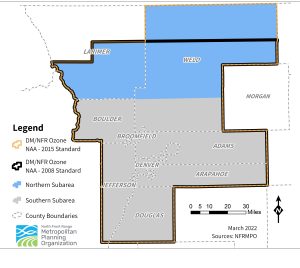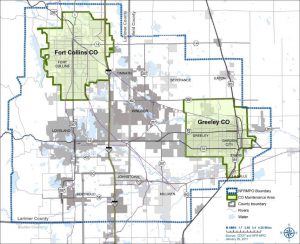The quality of the air impacts human health, agriculture, and visibility, and is also an important consideration for transportation planning. The NFRMPO is the designated lead planning agency for Carbon Monoxide (CO) and works with the Regional Air Quality Council (RAQC), which is the designated lead planning agency for ozone. In addition, the NFRMPO works with the Air Pollution Control Division (APCD) and the Environmental Protection Agency (EPA) to develop plans to address air quality issues and ensure the NFRMPO’s regional Transportation Plans meet or exceed air emission requirements.
While levels of carbon monoxide in the region have been reduced below the national standard, ozone in the region is still exceeding the national standard. To learn about how ozone is formed and its health impacts, visit the What is Ozone? page.
Carbon Monoxide Maintenance Areas within the NFRMPO Region
Fort Collins and Greeley are both Carbon Monoxide Maintenance Areas, meaning the cities no longer exceed standards for carbon monoxide and must meet maintenance requirements. Fort Collins completed its second 10-year maintenance plan, which lasted from 2013 through 2023. Greeley completed its second 10-year maintenance plan, which lasted from 2009 through May 2019.
Denver Metro – North Front Range (DM/NFR) Ozone Nonattainment Area

The NFRMPO region is within the Northern Subarea of the nine-county Denver Metro – North Front Range Ozone Nonattainment area. In 2019, the area was downgraded from a Moderate Nonattainment area to a Serious Nonattainment area by the EPA under the 2008 ozone standard for not reaching required ozone reductions. The region is also designated as a Marginal Nonattainment area by the EPA under the 2015 ozone standard. In 2022, EPA reclassified the region to Severe Nonattainment for the 2008 standard and Moderate Nonattainment for the 2015 standard. Learn more by viewing the Air Quality Fact Sheet.
Additional information is available at:
- Colorado Air Pollution Control Division
- Regional Air Quality Council
- Air Quality Forecast at AIRNow.gov
Ozone
Ozone serves as a protective layer in the stratosphere, but is unhealthy at ground level. When emissions from local industry, gasoline-powered vehicles, and paints are heated up by the sunlight, ozone forms and can act as a harmful air pollutant. Because ozone reacts with the addition of heat from sunlight, it is worst in the summer months when it is the hottest and when there is less wind.
According to the OzoneAware website:
At ground level, ozone is a health hazard for all of us, especially the young and elderly. Those who are active and exercising outdoors may experience breathing difficulties and eye irritation. Prolonged exposure may result in reduced resistance to lung infections and colds. Ozone can also trigger attacks and symptoms in individuals with pre-existing conditions, like asthma or other respiratory infections like chronic bronchitis and COPD (Chronic Obstructive Pulmonary Disease).
When ozone is particularly bad, the RAQC and the Colorado Department of Public Health and Environment (CDPHE) issue Ozone Alerts. These reports are automatically updated on the NFRMPO website and are tweeted on the NFRMPO’s Twitter account (@NFRMPO).
Learn more about ozone and simple steps you can take to reduce emissions from the RAQC:
Conformity
The NFRMPO must prove it can meet air quality conformity for transportation projects within the region to continue to receive federal funding. The NFRMPO’s Transportation Improvement Program (TIP) and projects must be in line with air quality standards. Each update to the TIP and the Regional Transportation Plan (RTP) must obtain approval from CDPHE, AQCC, FHWA, and FTA to ensure the projects meet these standards.
Conformity determination reports for current and previous RTPs and TIPs are available below.
Current Conformity Determination
Conformity Determination for the 2050 RTP and FY2024-2027 TIP
Ozone and Carbon Monoxide Conformity Report – 9/7/2023
Conforming Alternate Version of the Current Conformity Determination
Conformity Determination for the 2050 RTP and FY2024-2027 TIP
Conforming Alternate Version: Ozone and Carbon Monoxide Conformity Report – 9/7/2023
Anyone needing special accommodations to access the content of the conformity determination should contact staff@nfrmpo.org or (970) 800-9560.
Previous Conformity Determinations
Conformity Determination for the 2045 RTP 2022 Update
Ozone and Carbon Monoxide Conformity Report – 10/6/2022
Conformity Determination for the FY2023-2026 TIP
Ozone and Carbon Monoxide Conformity Report – 5/10/2022
Conformity Determination for the FY2022-2025 TIP
Ozone and Carbon Monoxide Conformity Report – 5/7/2021
Conformity Determination for the 2045 RTP
Ozone and Carbon Monoxide Conformity Report – 9/5/2019
Conformity Redeterminations for the 2040 RTP and FY2020-2023 TIP
Carbon Monoxide Conformity Report – 6/6/2019
Ozone Conformity Report – 6/6/2019
Original Amended 2040 RTP Conformity Determinations
Carbon Monoxide Conformity Report – 3/3/2017
Ozone Conformity Report – 3/3/2017
Original FY2019-2022 TIP Conformity Determinations
Carbon Monoxide Conformity Report – 6/6/2018
Ozone Conformity Report – 6/6/2018
All regionally significant projects, regardless of funding source, must be included in the TIP and RTP and associated conformity determination to proceed. In June 2014, the NFRMPO’s Planning Council defined seven types of projects as regionally significant. The definition is provided in the document below.
Air Quality Significant Project Definition
NFRMPO Air Quality Significant Project Definition for Conformity as of 9/7/2023:
- Adding at least two (2) through lane miles or completing a regional connection along a regionally significant corridor (RSC);
- Adding a new intersection on principal arterials or above; Adding new interchanges or grade-separated intersections; Major improvements to existing interchanges, excluding drainage improvements and ramp widening;
- Regional transit projects on fixed guideways, which offer a significant alternative to regional roadway travel;
- Addition or deletion of major bus routes with 3,000 riders per day, taking into account existing service levels.
Project contact: Becky Karasko, AICP — (970) 289-8281, bkarasko@nfrmpo.org

